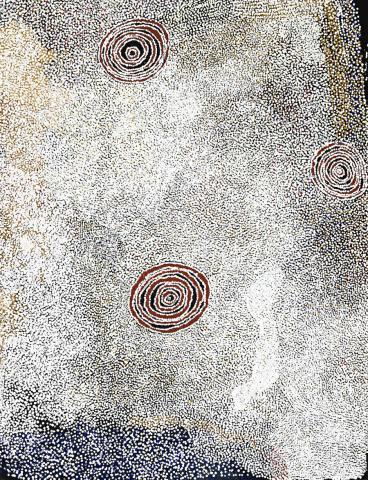ROCKHOLES AND COUNTRY NEAR THE OLGAS, 2007
BILL WHISKEY TJAPALTJARRI
synthetic polymer paint on linen
182.0 x 140.0 cm
inscribed verso: artist's name, title, size and Watiyawanu Artists of Amunturrngu cat: 77-07281
Watiyawanu Artists of Amunturrngu, Mount Liebig
John Gordon Gallery, Coffs Harbour, New South Wales
Private collection, Melbourne
Bill Whiskey Tjapaltjarri, John Gordon Gallery, Coffs Harbour, 20 October – 17 November 2007 (illus. in exhibition catalogue)
This work is accompanied by a certificate of authenticity from Watiyawanu Artists of Amunturrngu
This major painting comes from the second year of Bill Whiskey Tjapaltjarri's remarkable but relatively short painting career. As one of the suite of eleven important large works in his first solo exhibition, it is historically significant not just for the way it reveals his innate 'genius' for handling monumental scale in a spontaneous fashion, but also because it demonstrates how his signature 'style' was fully (and uncannily)articulated at the outset. Nicolas Kachel emphasizes this same quality when he recalls: 'In December 2005, Bill Whiskey Tjapaltjarri walked into the painting room at Mount Leibig, previously the exclusive reserve of women, and requested canvases and paints for himself. And so, at 85 years, he became an artist.'1
Painted when he was 87, this painting was nonetheless exceptional in that exhibition for the unique manner in which the artist built up an extremely thick and complex surface. Composed of dotting so various in size and density it seems to swarm across the surface. At the same time it works omni-directionally in that it opens out virtually to an infinite depth of field, supported by the powerful resonance of the profound black that is not so much a background as a form of limitless space. Yet, when examined more closely, the shimmering myriad of dots are revealed as an almost 3-D compound structure with a glossy tachistic sheen that at times is sculptural. Art Advisor Glenis Wilkin's writes: 'Sometimes I say to him, 'Do you think that's enough dotting?' But he'll just keep going - all I know is that the more dots he can get onto the canvas the better he likes it.'2
Yet the other distinct feature of the painting is the way in which the artist has suppressed colour by mostly burying it beneath the swathes of white micro-over-dotting. Working pointilistically, the coloured and the white dots mix optically according to one's distance and angle to the surface of the painting. This engineering of a painting as an optical colour-machine to generate shimmering and ephemeral light effects was also exploited by the French pointillists. Yet here this painterly device must be considered even more sharply focused because it embodies how light is refracted into a rainbow spectrum by white quartz crystals in powerful desert sunlight. White quartz goes to the very heart of Bill Whiskey's main Cockatoo Dreaming Story as it represents the cockatoo feathers scattered on the spinifex after an epic battle with an eagle. Perhaps that ritual significance also explains why the art advisor, when it came to this painting, really couldn't stop him dotting.
1. Bill Whiskey Tjapaltjarri, John Gordon Gallery, Coffs Harbour, 2007, unpaginated
2. Ibid.
